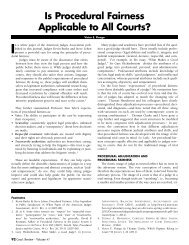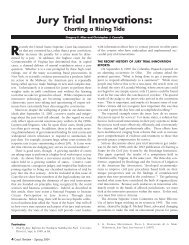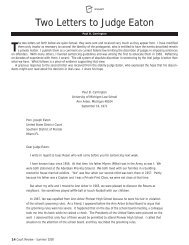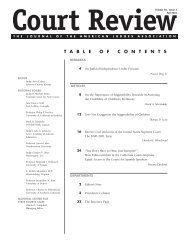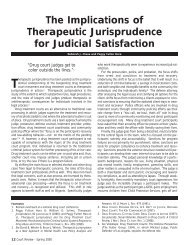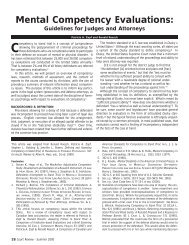Special Issue on Procedural Fairness - American Judges Association
Special Issue on Procedural Fairness - American Judges Association
Special Issue on Procedural Fairness - American Judges Association
- No tags were found...
Create successful ePaper yourself
Turn your PDF publications into a flip-book with our unique Google optimized e-Paper software.
[W]e highlightthe importance ofdistributive justicewith the goal ofraising awarenessof the factors thatcan influenceperceivedoutcome fairness.ized, arrested and incarcerated),<strong>on</strong>e’s proximity to thecriminal justice system clearlyinfluences an individual’s viewof appropriate penal sancti<strong>on</strong>.32 Research shows a differencein the fairness of outcomeratings between Whitesand affluent Blacks 33 and alsobetween Whites and lowincomeBlacks. 34 As <strong>on</strong>e mightc<strong>on</strong>clude, race and socioec<strong>on</strong>omicstatus are intimatelytied and pose a “double threat”for minority offenders.Race is not the <strong>on</strong>ly demographic variable that influencesattitudes toward the criminal justice system. Men and womenhave also been found to vary in their views toward crime andcorrecti<strong>on</strong>al policies. 35 Whereas men are more likely to supportcapital punishment as a means for corrective acti<strong>on</strong>,women tend to focus more <strong>on</strong> the individual and show greatersupport for rehabilitative efforts for criminal offenders. Bothagree that the government should punish and hold c<strong>on</strong>victedcriminals accountable, but women favor a standard of care thatprovides assistance to meet the needs of offenders, suggestingthat their goals in distributing penalties are different frommen’s. 36This attitudinal difference between men and women in recommendati<strong>on</strong>sfor legal outcomes is also prominent in otherdomains. For example, Sweeney and McFarlin found genderdifferences in men’s and women’s reliance <strong>on</strong> distributive orprocedural justice in expressing job satisfacti<strong>on</strong>. 37 For women,fair processes were more important in their job satisfacti<strong>on</strong>evaluati<strong>on</strong>s, lending to a procedural justice philosophy.Satisfacti<strong>on</strong> for men, however, was more outcome-orientedand therefore based more <strong>on</strong> an assessment of distributive fairness.38 Women show a str<strong>on</strong>ger preference for equality thanmen, and they are also more sensitive to variati<strong>on</strong>s in merit andneed. 39 Scott and colleagues speculate that women’s greatersensitivity to factors such as merit and need might reflect moregeneral gender differences in moral reas<strong>on</strong>ing, in particular agreater sensitivity am<strong>on</strong>g women to c<strong>on</strong>textual features. 40There is reas<strong>on</strong> to suppose that gender differences in distributivejustice may be applied to other c<strong>on</strong>texts, such as legal disputeresoluti<strong>on</strong>.Overall, these findings <strong>on</strong> individual differences suggesttwo things. First, litigants will have different expectati<strong>on</strong>s andpreferences about what sorts of outcomes are most fair,depending <strong>on</strong> their demographic characteristics. Althoughthere are criminal and civil codes, sentencing practices, andinformal norms that serve to ensure fair treatment under thelaw, <strong>on</strong>e pers<strong>on</strong>’s noti<strong>on</strong> of what is fair is not necessarily thesame as another’s. Sec<strong>on</strong>d, judges who come from differentbackgrounds will have a different sense of what c<strong>on</strong>stitutes afair and just outcome.RECOMMENDATIONS AND CONCLUSIONSBurke and Leben c<strong>on</strong>clude their article by offering a numberof recommendati<strong>on</strong>s for change. Specifically, they ask:“What can an individual judge, individual court, court administrators,researchers, judicial educators, and court leaders doto enhance procedural fairness?” We have no quarrel with theirrecommendati<strong>on</strong>s, the vast majority of which are reas<strong>on</strong>able,feasible, inexpensive, and likely to accomplish their desiredaim. We do not make analogous recommendati<strong>on</strong>s for whatjudges and courts can do to enhance distributive fairness; 41rather, in this c<strong>on</strong>cluding secti<strong>on</strong> we highlight the importanceof distributive justice with the goal of raising awareness of thefactors that can influence perceived outcome fairness.A hallmark characteristic of both the criminal and civil justicesystems is that <strong>on</strong>ly <strong>on</strong>e side wins; and often both sideswalk away disappointed. 42 Criminal c<strong>on</strong>victi<strong>on</strong>s are “wins” forthe prosecuti<strong>on</strong> (and are touted as such in electi<strong>on</strong> campaigns)and “losses” for defendants; whereas most civil cases are essentiallyzero-sum games, with <strong>on</strong>e party’s losses mirroring theopposing party’s gains. Thus, there would seem to be little32. Miller et al., supra note 30, at 316.33. John Hagan & Celesta Alb<strong>on</strong>etti, Race, Class, and the Percepti<strong>on</strong>sof Criminal Justice in America, 88 AM. J. SOCIOL. 329 (1982).34. Martha L. Henders<strong>on</strong> et al., The Impact of Race <strong>on</strong> Percepti<strong>on</strong>s ofCriminal Injustice, 25 J. CRIM. JUST. 447 (1997).35. Brand<strong>on</strong> K. Applegate, Francis T. Cullen & B<strong>on</strong>nie S. Fisher,Public Views Toward Crime and Correcti<strong>on</strong>al Policies: Is There aGender Gap? 30 J. CRIM. JUST. 89 (2002).36. Id. at 98.37. Paul D. Sweeney & Dean B. McFarlin, Process and Outcome:Gender Differences in the Assessment of Justice, 18 J.ORGANIZATIONAL BEHAVIOR 84 (1997).38. Id. at 92.39. Michelbach et al, supra note 8, at 536 (finding women are moreegalitarian and more sensitive to need); Scott et al., supra note 7,at 763-64 (finding women are more egalitarian and more sensitiveto merit).40. E.g., CAROL GILLIGAN, IN A DIFFERENT VOICE (1982).41. Doing so would entail a normative discussi<strong>on</strong> of the principlesthat the civil and criminal justice systems should adhere to inresolving disputes, and such philosophical discursi<strong>on</strong>s would takeus too far afield from our more modest aim of describing theimportance of distributive justice for the courts.42. It is theoretically possible for both sides to leave the process satisfiedwith the outcome. In a criminal case, for example, the prosecuti<strong>on</strong>and the defendant might both be satisfied with c<strong>on</strong>victi<strong>on</strong><strong>on</strong> a lesser charge, as opposed to either c<strong>on</strong>victi<strong>on</strong> <strong>on</strong> the mostserious charge (best outcome from the prosecuti<strong>on</strong>’s perspective)or an acquittal (best outcome from the defendant’s perspective).Similarly, a civil plaintiff and defendant might both be pleased thatthe award was not more (from the defendant’s perspective) or less(from the plaintiff’s perspective) than it might have been otherwise.However, such “win-win” situati<strong>on</strong>s rarely, if ever, happen.More often, both sides would experience disappointment fromthese sorts of compromise outcomes. See Jessica Pears<strong>on</strong>, AnEvaluati<strong>on</strong> of Alternatives to Court Adjudicati<strong>on</strong>, JUST. SYS. J., 420(1982); Val Reid, Small Claims, Big Questi<strong>on</strong>s, LEGAL ACTION,March 2007, at 11, 11-12, available at http://www.asauk.org.uk/fileLibrary/pdf/smclmsbq.pdf.76 Court Review - Volume 44




